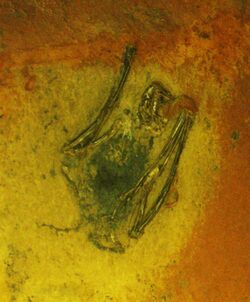Biology:Hassianycteris
From HandWiki
Short description: Extinct genus of bats
| Hassianycteris | |
|---|---|

| |
| Specimen of H. messelensis from the Messel Pit of Germany | |
| Scientific classification | |
| Domain: | Eukaryota |
| Kingdom: | Animalia |
| Phylum: | Chordata |
| Class: | Mammalia |
| Order: | Chiroptera |
| (unranked): | Microchiropteramorpha |
| Family: | †Hassianycterididae |
| Genus: | †Hassianycteris Smith & Storch, 1981 |
| Species | |
| |
Hassianycteris is an extinct genus of Early Eocene (Ypresian) to Middle Eocene (Lutetian) bats from the Hassianycterididae with four or five known species: the type (H. messelensis), H. magna, and H. revilliodi, all found in the Messel pit, Germany ,[1][2][3] H. kumari, found in the Cambay Shale Formation (Vastan Lignite Mine), India ,[4] and the possible fifth species "H." joeli, found in the Kortijk Clay Formation, Belgium,[5] which may instead belong to Onychonycteridae.[3] The Messel bats Palaeochiropteryx and Hassianycteris (alive roughly 48 million years ago) are the first fossil mammals whose colouration has been discovered: both were reddish-brown when alive.[6][7]
References
- ↑ Smith, J.D. Storch, G. (1981): New Middle Eocene bats from “Grube Messel” near Darmstadt, W-Germany. Senckenbergiana biologica, 61 (3/4): 153-167.
- ↑ Richter, G. & Storch, G. (1980): Beiträge zur Ernährungsbiologie eozäner Fledermäuse aus der "Grube Messel". Natur und Museum, 110 (12), p. 353-367
- ↑ 3.0 3.1 Smith, Thierry; Habersetzer, Jörg; Simmons, Nancy B.; Gunnell, Gregg F. (2012), Gunnell, Gregg F.; Simmons, Nancy B., eds., "Systematics and paleobiogeography of early bats", Evolutionary History of Bats: Fossils, Molecules and Morphology, Cambridge Studies in Morphology and Molecules: New Paradigms in Evolutionary Bio (Cambridge: Cambridge University Press): pp. 23–66, doi:10.1017/cbo9781139045599.003, ISBN 978-0-521-76824-5, https://www.cambridge.org/core/books/evolutionary-history-of-bats/systematics-and-paleobiogeography-of-early-bats/4E2C021DC0CE6B41A17F1AA7E0E38580, retrieved 2024-01-23
- ↑ T. Smith, R. S. Rana, P. Missiaen, K. D. Rose, A. Sahni, H. Singh, and L. Singh. 2007. High bat (Chiroptera) diversity in the Early Eocene of India. Naturwissenschaften 94(12):1003-1009
- ↑ T. Smith and R. Smith. 2003. Terrestrial mammals as biostratigraphic indicators in upper Paleocene-lower Eocene marine deposits of the southern North Sea Basin. Geological Society of America Special Paper 369:513-520
- ↑ "Paleontologists Determine Original Color of Extinct Bats". SciNews. 29 September 2015. http://www.sci-news.com/paleontology/science-original-color-extinct-bats-03283.html.
- ↑ Colleary, C.; Dolocanc, A.; Gardnerd, J.; Singha, Suresh; Wuttkee, M. (2015). "Chemical, experimental, and morphological evidence for diagenetically altered melanin in exceptionally preserved fossils". Proceedings of the National Academy of Sciences of the United States of America 112 (41): 12592–12597. doi:10.1073/pnas.1509831112. PMID 26417094. Bibcode: 2015PNAS..11212592C.
Wikidata ☰ Q104882675 entry
 |

